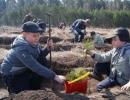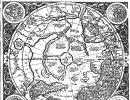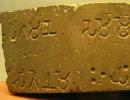What part of the word is called the main significant. Word formation. Base and end
Words consist of minimal (hereinafter indivisible) meaningful parts, called morphemes(from Greek. morphe- form): roots, prefixes, suffixes and endings. The doctrine of significant parts of a word (morphemes) is called morphemics.
According to their role, meaning and place in the word, morphemes are divided into root and official(affixal).
The ending- a variable significant part of the word, indicating the connection of the word with other words in the sentence. Expresses meanings: for nominal parts of speech and participles - gender, number and case; verbs in the present tense have persons and numbers, in the past tense - gender and number.
Zero ending- an ending that is not expressed by sounds and is found when comparing word forms. It is an indicator of a certain grammatical form. For example, the zero ending of a noun wind indicates I. (V.) p. h.m.r.; null verb ending spoke- per unit h.m.
To highlight ending, you should change the word, i.e. decline (names) or conjugate (verbs). Separating the ending, we simultaneously highlight the base.
The foundation
The foundation- part of the modified word without ending, expressing its lexical meaning: light, answer, work .
In addition to the root, the stem may include a prefix (s) and a suffix (s).
Root- the main indivisible part of related (single-root) words, which contains their common lexical meaning (shore - shore - coastal - coastal). To find the root of a word, you need to find related words. So, the words water, water, water, waterman, water, underwater, surface water have a common root -water-. Such a group of single-root words is called nest.
Console, or prefix (from lat. praefixus - attached in front) - a service morpheme that comes before the root and serves to form new words or their grammatical forms. For example: read up, top, unrepeatable.
Suffix(from lat. suffixus - attached, pinned) - an auxiliary morpheme, standing after the root and serving to form new words or their grammatical forms. For example: floating, get used to - get used to, reader.
The base equal to the root is called not a derivative(house, window, book). A stem that also includes one or more auxiliary morphemes (suffixes or prefixes) is called derivative(flight, day, justice).
Prefixes and suffixes can be word-forming and shaping.
derivational(word-forming) are called prefixes and suffixes that serve to form new words ( morning - morning, know - knowing, true - not true).
Form-building(formative) prefixes and suffixes are used to form word forms (draw- perfect form of the verb paint, pure- the superlative form of the adjective clean, wrote- past tense form of the verb write).
In Russian, the same prefixes serve to form words of different parts of speech ( interlocutor, take place; recognize, sign), and most suffixes serve to form any one part of speech ( -chik-, -ost and others - nouns, -sk-, -n- and others - adjectives, -ova-, -eva-, -iva-, -iva- and others - verbs, -o-, -e-, -mu-, -him-, -and- and others - adverbs).

word formation- a branch of the science of language that studies the structure of words (what parts they consist of) and how they are formed.
Word composition.
The word consists of a stem and an ending. They are based on: prefix, root suffix. Prefix, root, suffix, ending - parts of a word.
Base and end.
In changeable independent words, the stem and ending are distinguished, and in unchangeable words, only the stem.
The foundation- this is a part of the modified word without an ending. The basis of the word is its lexical meaning.
The ending- this is a variable significant part of the word, which forms the form of the word and serves to connect words in a phrase and sentence.
Notes.
1. To highlight the ending, you need to change the word.
2. Invariable words have no endings.
When a word changes or any form of it is formed: number, gender, case, person, the endings change.
The ending expresses different grammatical meanings: for nouns, numerals and personal pronouns (without a preposition, go with it) - case and number; for adjectives, participles, some pronouns - case, number, gender; for verbs in the present and future tense - person and number, and in the past tense - gender and number.
The end may be zero, that is, one that is not expressed by sounds. It is found by comparing the forms of the word. In the nominative case, the zero ending (like any other in oblique cases) means that the noun horse, eagle used in the nominative case, singular, male, 2nd declination.
At the basis of an independent word, significant parts of the word can be distinguished: prefix, root, suffix.
Root of the word.
Root is the main part of the word, which contains general meaning all single-root words. Words with the same root are called single root.
Notes.
- Single-root words can refer to one part of speech or to different ones.
- It is necessary to distinguish between coinciding in sound, but different in meaning (homonymous) roots. Words with similar roots are not cognate.
- There are relatively few words consisting of a root and an ending in Russian; most word stems consist of a root and a suffix; root, prefix and suffix.
- Some roots in the "free" form (root + ending) do not occur. They are found in words only in combination with prefixes, suffixes or other roots:
- de -- put on, change clothes;
- nya -- borrow, hire, take away;
- Fri -- chick, bird, bird;
- syag -- oath, reach, encroach;
- at -- undress, put on;
- st -- street, lane;
- th -- enter, move away, pass, enter.
Suffix.
Suffix- this is the significant part of the word, which is located after the root and usually serves to form words.
Note.
Suffixes can serve to form word forms.
Console.
Console- this is the significant part of the word, which is located before the root and serves to form words. Prefixes form words with a new meaning.A word may contain not one, but two or more prefixes.
Notes.
- The vast majority of prefixes are native Russian ( o-, from-, under-, over-, re- and etc.). There are few foreign prefixes in Russian: a-, anti-, archi-, inter-, counter-, ultra-, de-, dez-, dis-, re-, ex-, im-.
- Prefixes can be multi-valued. Yes, attachment at- means approaching, joining, incomplete action, being close to something.
- In many words, the prefixes have grown together with the root and are no longer distinguished as independent parts of the word: admire, admire, get, venture, overcast, adore, disappear and etc.
Word formation methods.
New words in Russian are formed on the basis of words, phrases, less often - sentences, which for a new word are initial.
Words in Russian are formed in the following main ways: prefix, suffix, prefix-suffix, non-suffix, addition, transition from one part of speech to another.
Attachment method.
When forming words prefixed way the prefix is attached to the original, already finished word. The new word refers to the same part of speech as the original word. This is how nouns, adjectives, pronouns, verbs, adverbs.
suffix way.
Suffix way is that a suffix is added to the base of the original word. Thus the words of all are formed independent parts speech.
Words formed in a suffixal way are usually another part of speech.
The suffix method is the main one for the formation of nouns, adjectives and adverbs. It is more complex than the prefix method, since the suffix is added not to the whole word, but to its stem, and the stem of the word sometimes changes: a part of the stem is cut off, its sound composition changes, sounds alternate.
Prefixed-suffixal way.
Prefixed-suffixal method is to simultaneously attach a prefix and a suffix to the base of the original word.
Most often nouns with suffixes are formed in this way -nick, -th (e), -ok, verbs with suffix -sya, adverbs in prefix on- and suffixes -and, -mu, -him.
Non-suffix way.
Non-suffix way consists in the fact that the ending is discarded from the word, or the ending is simultaneously discarded and the suffix is cut off.Addition as a way of forming words.
Addition consists of combining two words in one word. As a result of the addition, Difficult words.Compound words are words that have two (or more) roots. They are formed. as a rule, from independent parts of speech, keeping in its composition the whole word or part of it. In a compound word, there can be connecting vowels between the roots about and e.
Notes.
- Can be used as a connecting vowel and: five-year.
- Compound words can be without a connecting vowel.
- Addition of whole words: sofa bed, test pilot;
- Adding word stems without connecting vowels ( wall newspaper, sports ground, car factory) or connecting vowels about and e (snowfall, locomotive, excavator);
- With connecting vowels about and e, connecting part of the stem of the word with the whole word: new building, reinforced concrete, grain procurement, arts and crafts;
- Addition of stems with simultaneous addition of a suffix: farming, dizzy;
- Merging words: evergreen, highly venerated, daredevil, the undersigned.
Addition of abbreviated bases.
Many words are formed by addition of abbreviated stems of original words. As a result, compound words.
Compound words are formed:
- adding syllables or parts of words of the full name: collective farm (collective farm), educational program (liquidation of illiteracy), special correspondent (special correspondent);
- adding the names of the initial letters: Central Committee (Central Committee), VDNKh (Exhibition of Achievements of the National Economy);
- addition of initial sounds: university (higher educational institution), Moscow Art Theater (Moscow Art Academic Theatre);
- in a mixed way (addition of a syllable with a sound, a sound with a syllable, letters with a sound, etc.): glavk (main committee), district (district department of public education).
Transition of words from one part of speech to another.
Words are also formed transition from one part of speech to another. At the same time, being used in the role of another part of speech, they acquire a different general meaning, lose a number of their grammatical features. For example: we were walking (word step, being an adverb, does not change).
In Russian, words consist of significant parts - morphemes.
The root, prefix, suffix, ending are significant parts of a word, or morpheme.
Morphemics is a section of grammar that studies the composition of a word.
Note!
Concepts should be distinguished part of a word and meaningful part of a word. A syllable or several syllables can be a part of a word; they do not have a meaning.
Significant parts of the word are morphemes, they necessarily have a meaning.
In Russian, as in Ukrainian, the same graphic signs are used to denote morphemes:
ROOT is the common part related words, which contains the main value.
SUFFIX is the significant part of the word that comes after the root. The suffix is used to form new words: village - rural, live - resident.
PREFIX - a significant part of the word that comes before the root. The prefix is used to form words: city - suburb.
ENDING - a significant part of the word that forms the form of the word: street - streets, street, streets.
In writing, when transferring a word from one line to another, one letter cannot be torn off from one morpheme and attached to another morpheme. For example, you need to transfer: under-water, junction, tell-say and etc.
The same word can have different forms: city city, city, city; rural, rural, rural, rural; travel, travel, travel. Such words are called inflected. All modified words consist of a stem and an ending.
BASE is a part of a word without an ending: urban (urban- basis and -oh- the ending).
The base must include the root. The stem may include other morphemes - prefixes, suffixes.
ENDING - a significant part of a word that changes the forms of words. The ending can consist of one or more sounds (letters) or be zero: house, but to house-y, house-a; birch - birch-oh.
Invariable words have no endings and consist only of the stem: talking, having fun, riding.
So, let's repeat once again what parts the word in Russian consists of.
Root- the central part of the word, containing the main element lexical meaning, for example: for-dry-a, forest-noy. A compound word has more than one root: peat mining, deaf-blind-mute.
Console(prefix) - the part of the word that is in front of the root, for example: shake, attach, close-open.
Suffix- part of the word between the root and the ending, for example: active-ist-to-a, cut-to-a, obsolete-e-l-ost.
The ending(inflection) - the part of the word with which the word most often ends and which expresses the meaning of gender, number, case and person, for example: spring-a, beautiful-th, rowing-y. After the end, there can be a return particle -sya (-s) and a particle -te, for example: write-et-sya, rolled-a-s, go-eat-te.
Syllable is a sound or several sounds uttered by one push of exhaled air. Any syllable necessarily includes a vowel sound. A syllable can consist only of a vowel or a combination of a vowel with one or more consonants: o-si-na, id-ti, mo-lo-dets.
The word consists of parts: prefix, root, suffix, ending. They are also called morphemes. The prefix, root and suffix form the basis of the word, they are significant parts of the word. In other words: a word consists of a stem and an ending. The branch of science that studies the structure of words and how they are formed is called word formation. It is necessary to separate the concepts of morphemic and word-formation parsing.
Names and designations
Each part of the word has a name and a visual designation (tracing). Designations are, as it were, "markers" that are attached to the corresponding part of the word from above, below or by a stroke.
prefix (or prefix)
- root
- suffix and postfix
- the ending
- stem and connecting vowel (or interfix)
Let's show the notation of morphemes with examples: vanguard n th , paragraph, no exit
In notebook sheets, words are usually written with a ballpoint pen, and parts of the words are highlighted with a pencil or a ballpoint pen of a different color. On school boards, parts of words are highlighted with a small or marker in a color that differs from the color of the word. Our site contains a brief dictionary of morpheme parsing with a visual designation of morphemes.
Morpheme groups
Morphemes are divided into three groups:
- root morpheme - root;
- word-forming morphemes - prefix, word-forming suffix;
- formative morphemes - ending, formative suffix.
The basis of the word includes the root and word-forming morphemes.
Fig 1. Schematic representation of parts of a word
Outside the framework of the school curriculum, a different terminology is used for non-root morphemes - affixes. There are other morphemes and their combinations, but they are not included in school curriculum, so we do not consider them in detail.
Any of the morphemes may be absent in the word, including the root. However, some scientists believe that the absence of a root is actually the presence of a zero root.
Modification of morphemes
Parts of a word may be subject to the loss of a sound or the replacement of one sound by another. Such modifications can occur in single-root words and in different forms of the same word:
. in prefixes: from cut - tear off, divide to divide - paint;
. in the roots: to irrigate - irrigation, asks - begs, cherish - shore - safe;
. in suffixes: knot - knot a - knot;
. in the endings: water - water, in the forest - about the forest.






